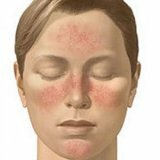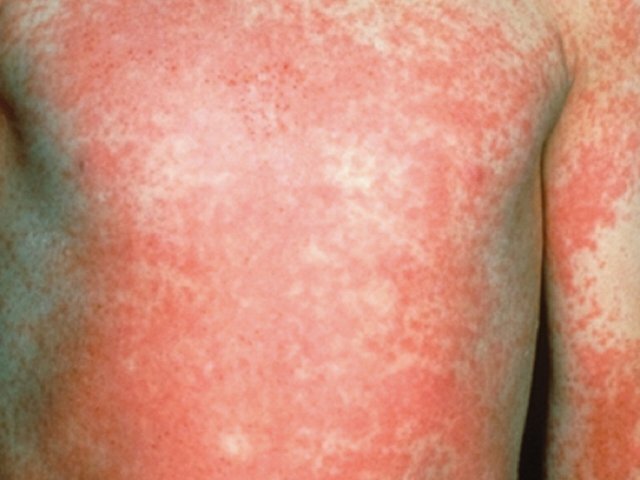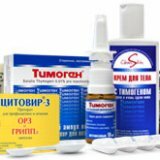Rosacea - Causes and Treatment
 The article describes a disease such as rosacea. It describes the symptoms of rosacea, possible causes of the appearance and methods of its treatment.
The article describes a disease such as rosacea. It describes the symptoms of rosacea, possible causes of the appearance and methods of its treatment.
What is rosacea?
Rosacea is a chronic( long-term) disease that affects the skin, and sometimes the eyes. The disorder is characterized by redness and pimples. In later stages, the skin becomes thickened. Rosacea affects the face, other upper parts of the body rarely participate.
Who is affected?
It affects people between the ages of 30 to 60 years. Rosacea is more common in women( especially menopause) than men. Although rosacea can develop in people of any age.
What does rosacea look like?
There are several signs and conditions associated with rosacea. These include frequent hot flashes, vascular rosacea, inflammatory rosacea and some other conditions that accompany the skin, eyes and nose.
Face washing is often accompanied by a burning sensation, especially when using creams or facial cosmetics. Thus the face swells up.
A condition called vascular rosacea, a symptom of it is persistent redness. Blood vessels under the skin of the face can expand, showing through the skin in the form of small red lines. This is called telangiectasia. Affected areas of the skin can be swollen and slightly warm.
A condition called inflammatory rosacea, its symptoms are persistent redness, papules( pink cones), and pustules( cones containing pus) on the skin. Inflammation of the eye and sensitivity, and also may appear telangiectasia.
In the later stages of rosacea, deep shades of red appear on the skin, and the inflammation of the eyes becomes evident. There are often numerous telangiectasias and nodules on the skin can become painful. A condition called rhinophyma can develop in men, this is a rare disease in women. Rinofima is characterized by enlarged, bulbous and red noses as a result of the enlargement of the sebaceous gland beneath the surface of the skin on the nose. People with rosacea can develop thickened skin on the forehead, chin, cheeks or in other areas.
How does the disease affect the eyes?
In addition to skin problems, up to 50 percent of people with rosacea have vision problems. Typical symptoms include redness, dryness, itching, burning, lacrimation and a feeling of sand in the eyes. The eyelids become inflamed and swollen. Some people describe the symptoms as eye sensitivity to light, blurred vision or vision is completely disturbed.
Rosacea: causes and treatment
Doctors do not know the exact cause of rosacea, but I believe that some people can inherit a tendency to develop a disorder. Some researchers believe that rosacea appears where the blood vessels expand too quickly.
The following factors that contribute to the development of rosacea have not yet been well studied. Some people claim that one or more of them exacerbate their situation: heat( including hot baths), exercise, sunlight, wind, very low temperatures, hot or spicy food and drinks, alcohol consumption, menopause, emotional stress andLong-term use of local steroids on the face. It can be considered that rosacea is caused by bacteria, but researchers have not established a link between rosacea and bacteria or other organisms on the skin, in the hair follicles or in other parts of the body.
Can I cure rosacea?
Although there is no cure for rosacea, it can be treated and controlled. A dermatologist( a doctor specializing in skin diseases) usually refers to rosacea. The goal of the treatment is to monitor the condition and improve the appearance of the patient's skin. This can take several weeks or months of treatment before a person notices the improvement of the skin. Some doctors prescribe antibiotics that are applied directly to the affected areas of the skin. For people with more severe cases, doctors often prescribe to take antibiotics inside.
There are people who fall into depression due to changes in the appearance of the skin. People often experience low self-esteem, feel uncomfortable about the appearance, and argue that their social and professional interaction with other people has an adverse effect. A doctor should support a person if he feels strangled and has other symptoms of depression, such as loss of appetite or trouble concentrating.
Doctors, usually in the treatment of eye problems associated with rosacea, prescribe antibiotics. People who have inflammation of the eyelids should observe the hygiene of the eyelids. The doctor may recommend cleaning them with a slightly diluted baby shampoo or applying warm( but not hot) compresses several times a day. When the eyes are badly affected, doctors prescribe steroid eye drops.
Electrosurgical and laser surgery, one of the treatment options, if there are red lines caused by dilated blood vessels, or if the rhinophyma develops. For some patients, laser surgery can improve the appearance of the skin with small scars or lesions. For patients with rhinophyma - surgical removal of excess tissue.
How to manage rosacea?
You can take several steps to keep the rosacea under control:
- Describe the factors that affect skin irritation and the development of rosacea.
- Most people should use sunscreen every day, this provides protection against UVA and UVB rays( ultraviolet rays), and has a sunscreen factor( SPF) of 15 or higher. Sunscreen is especially important for people whose skin is irritated by the sun.
- Use a mild moisturizer, it can be useful. It is necessary to avoid the use of any irritating products intended for the face. Some people believe that foundation cream effectively hides the redness of the skin, it is undesirable to use it.
- If your eyes are affected, then follow the doctor's plan and follow all the instructions strictly according to the instructions.



